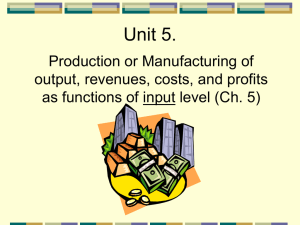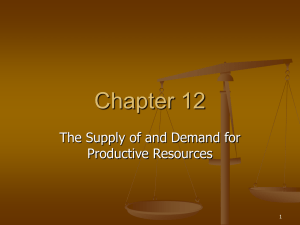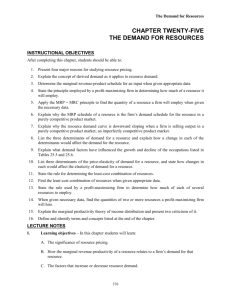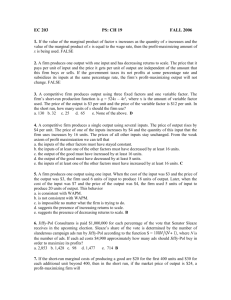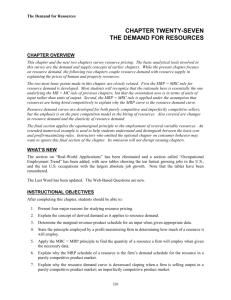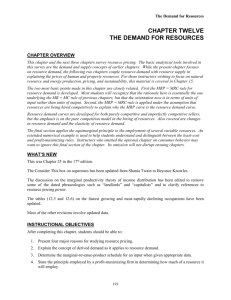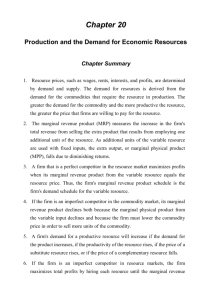Cost-minimizing input combinations - Rush's PAGES -->
advertisement
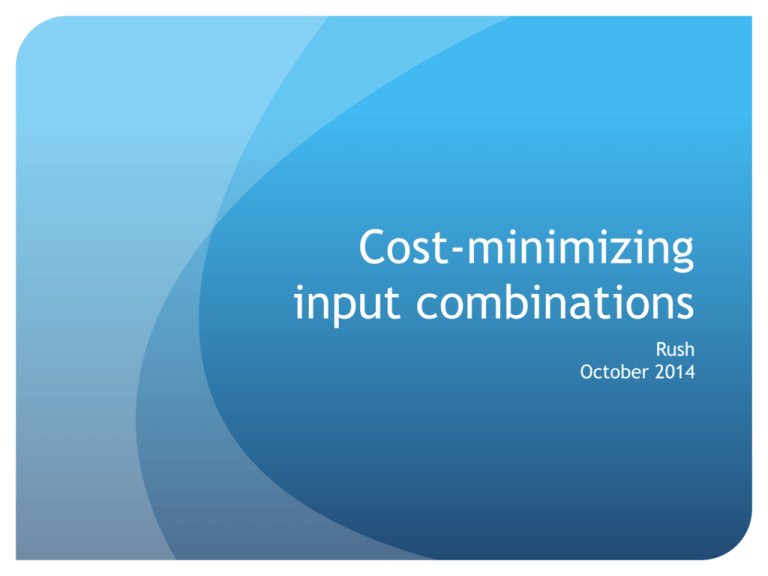
Cost-minimizing input combinations Rush October 2014 Today’s objectives Review marginal revenue productivity and firm resource demand Look at the optimal combination of resources for the competitive firm See pages 489-499 Resource pricing Firms demand resources – Focus on labor Resource prices are important: – Money-income determination – Cost minimization – Resource allocation – Policy issues Resource pricing Money-income determination – Resources prices are a major factor in determining the income of households. – Wage, rent, interest and profit to the household that supply those resources. Resource pricing Cost minimization – To the firm, resource prices are costs. – To obtain the greatest profit, the firm must produce the profit-maximizing output with the most efficient (least costly) combination of resources. Resource pricing Resource allocation – Resource prices allocate resources among industries and firms. – The efficient allocation of resources over time calls for the continuing shift of resources from one use to another. Resource pricing Policy issues – Role of government in resource pricing. – For example, should the government encourage or restrict labor unions? Resource demand In order to derive the resource demand, we assume that all resource markets are competitive (good and resource) In a competitive resource market, the firm is a price taker Its buying decisions do not influence the resource prices Resource demand The demand for resources is a “derived demand” – from the products that the resources help produce. Resources do not directly satisfy customer wants but do so indirectly through their use in producing goods and services. Households are the source of supply and firms are the source of demand in resource markets. Resource demand Marginal revenue product (MRP) – Change in TR resulting from unit change in resource (labor) A firm will hire an additional unit of a resource only if this increases the firm’s profits. - Econ. profit = tot. revenue – tot. cost Resource demand Rule for employing resources: Marginal revenue product = Marginal resource cost MRP = Change in Total Revenue/ Unit Change in Resource Quantity MRC = Change in Total (Resource) Cost/ Unit Change in Resource Quantity (similar to MC = MR rule of output side) Optimal level of resource use Marginal revenue product (MRP) = additional revenue associated with the use of an additional unit of a resource Marginal resource cost (MRC) = additional cost associated with the use of an additional unit of a resource Increase resource use if MRP > MRC Decrease resource use if MRP < MRC Optimal level of resource use: MRP = MRC Optimal combination of resources In the long run, all resource inputs are variable Choose optimal combination Minimize cost of producing a given output Maximize profit The least-cost rule Minimize cost of producing a given output Last dollar spent on each resource yields the same marginal product Marginal Product of labor (MPL) = Price of Labor (PL) Marginal Product of Capital (MPC) Price of Capital (PC) The least-cost rule An example Marginal Product of labor (MPL) Price of Labor (PL) Marginal Product of labor (MPL) = 10 (PL) = 1 = Marginal Product of Capital (MPC) Price of Capital (PC) > Marginal Product of Capital (MPC) = 5 (PC) = 1 https://www.youtube.com/watch?v=QzaM6JSQ6BE Profit-maximizing INPUT rule In a purely competitive market, MRP of each resource equals its price PL = MRPL and PC = MRPC MRPL PL = MRPC PC = 1 Profit-maximizing INPUT rule A firm will achieve its profit-maximizing combination of resources when each resource is employed to the point at which its MRP equals its resource price. Profit-maximizing OUTPUT rule In product markets, profit-maximizing output occurs where marginal revenue equals marginal cost (MR = MC). https://www.youtube.com/watch?v=xGkE0oHyNhk




